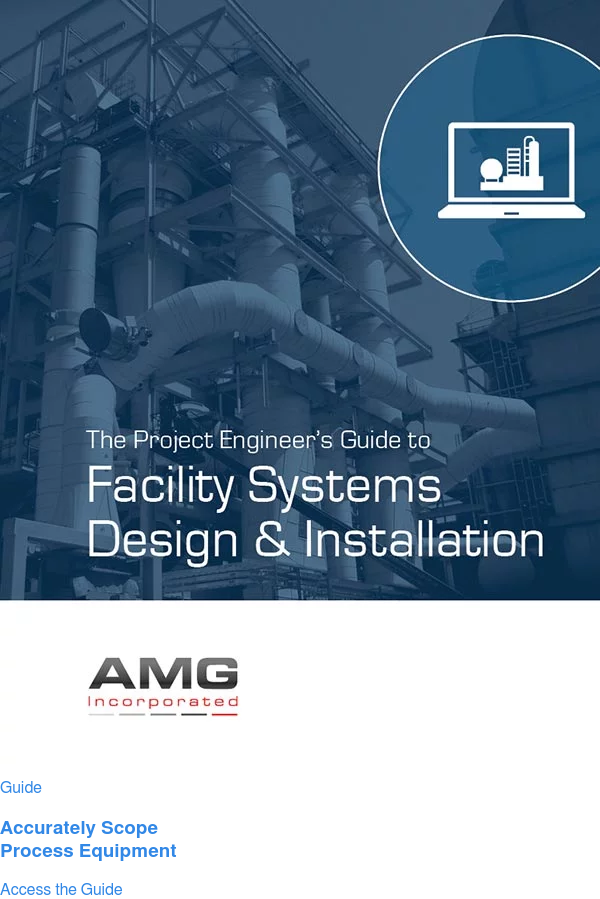Today’s industrial executives and facility engineers are under mounting pressure to improve current operations and usher new products into market while reducing the construction and engineering costs necessary to support those efforts.
Within the context of capital construction projects at a facility, achieving this goal hinges on the leader’s ability to appropriately understand the total cost of a project early on.
To this end, we’ve built a facility construction cost estimating tool based on 35+ years of experience within industrial and processing facilities that can be used to make a quick budgetary estimate of capital cost in the early stages of project development, when the preliminary flowsheets have been developed and the main items of equipment have been roughly sized and priced.
Download the template now, or read on to see how it works.
Identify the Cost of Process Equipment
Project executives understand the direct correlation between the cost of the process equipment required for the project and the overall facility construction cost.
The equipment cost should be considered as the total delivered cost of all the major equipment needed for the project—such as pumps, heat exchangers, process and storage vessels/tanks, reactors, columns, centrifuges, and so forth.
With this cost overview in place that this tool provides, Facility Executives and Project Engineers can begin to plan what it will take to design, build, install and commission the equipment.
If you know the cost of your process equipment, you can get an understanding of the construction efforts (and, therefore, the associated costs) required, which in turn can give you a much better grasp of the overall cost required for the project.
As we know, however, the cost of a facility project is much larger than simply buying equipment and installing it. It’s now time to understand in the various other associated costs of the project that you can expect to encounter.
Identify the Trades, Disciples, and Crafts Required for the Project
Within every facility construction project, there are several trades, disciplines, and crafts necessary to fulfill the project plan. We’ve found that those buckets can be categorized into the following line items for budget estimating:
- Site Development/Civil Works
- Buildings & Equipment Support
- Equipment Cost
- Equipment Installation
- Piping
- Electrical
- Instrumentation
- Process Sheet Metal
- Painting
- Process Insulation
- Crane & Equipment Rental
- Engineering
- Construction Management
- Construction General Conditions
- Contingency
How do you know what to budget for each item? Is there a formula to follow to give you some perimeters as you build a capital project budget?
Use the Factored Method to Estimate Each Trade, Discipline & Craft Cost
With each allocation line item determined for your project, you can estimate the costs associated for each using the equipment cost as the baseline.
To convert this formula, we use the “Factored” method of cost estimation that is often attributed to Lang (1948). The fixed capital cost of the project is estimated as a function of the total purchase cost of the project’s process and utility equipment:
Total Construction Cost ($) = Factor x Equipment Cost ($)
Note that Factor = “Lang” factor; a process or “complexity” based value. This value can range from as low as 1.5 for a carbon steel based process with limited piping, instrumentation, and structures—to as high as 4.5 for a process involving exotic alloys, extensive complex piping, sterile conditions, complex instrumentation and large, heavy structures.
Our estimating tool is based on a Lang factor of approximately 2.6, which essentially means that the equipment cost is 38% of the total project cost.
Employ Relative Magnitude to Flex Budget Predictions Based on Unique Considerations
This is a great start to identifying total project cost, but as you know, some tasks are more difficult or require more time than others to complete. This is where something called relative magnitude comes into play to support budgeting estimations.
Our tool incorporates a “Relative Magnitude” adjustment feature that enables you to select a “Relative Magnitude” value for each trade or discipline to account for the type and complexity of the project that’s being estimated.
We use a default value of 3.0 for relative magnitude. If the value of 3.0 is inputted for each trade/discipline/craft (i.e., construction development, process sheet metal, piping, etc.), the resulting estimate will be based on the historical “typical” cost profile.
These projections are based on 35+ years of historical cost profiles across various chemical, agricultural commodity, biotechnology, and mineral processing facility construction projects.
Download Our Facility Project Estimating Tool
Our free Factored Cost Capital Estimating Tool helps project executives develop a factored Capital Construction Cost Estimate based on known or estimated process equipment cost—while also providing estimated values for each construction trade, craft and discipline associated with the project.
Download and use it today!


